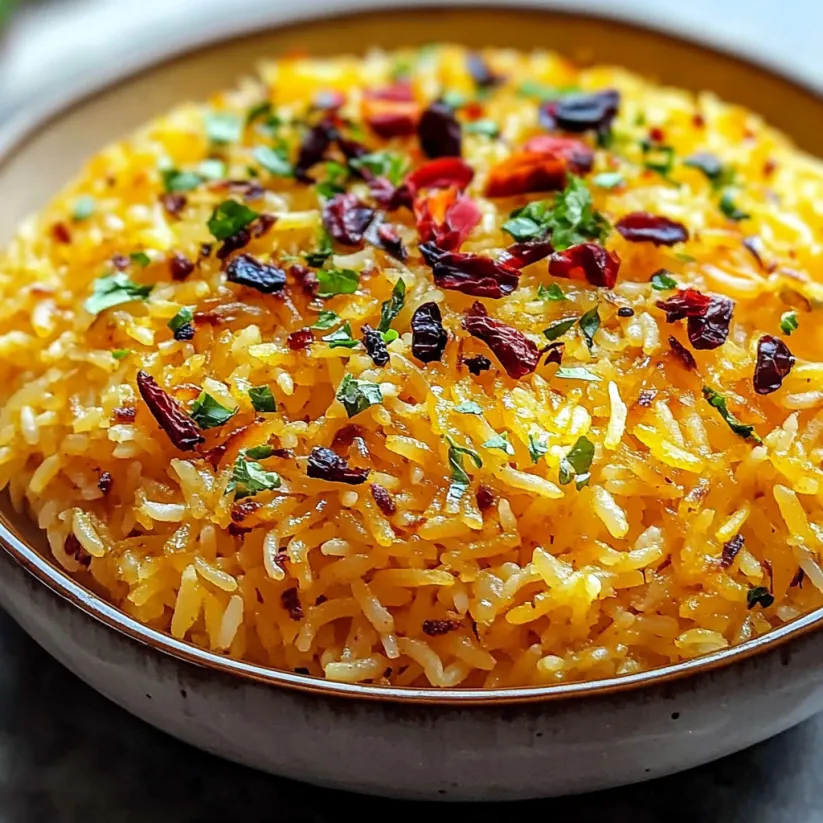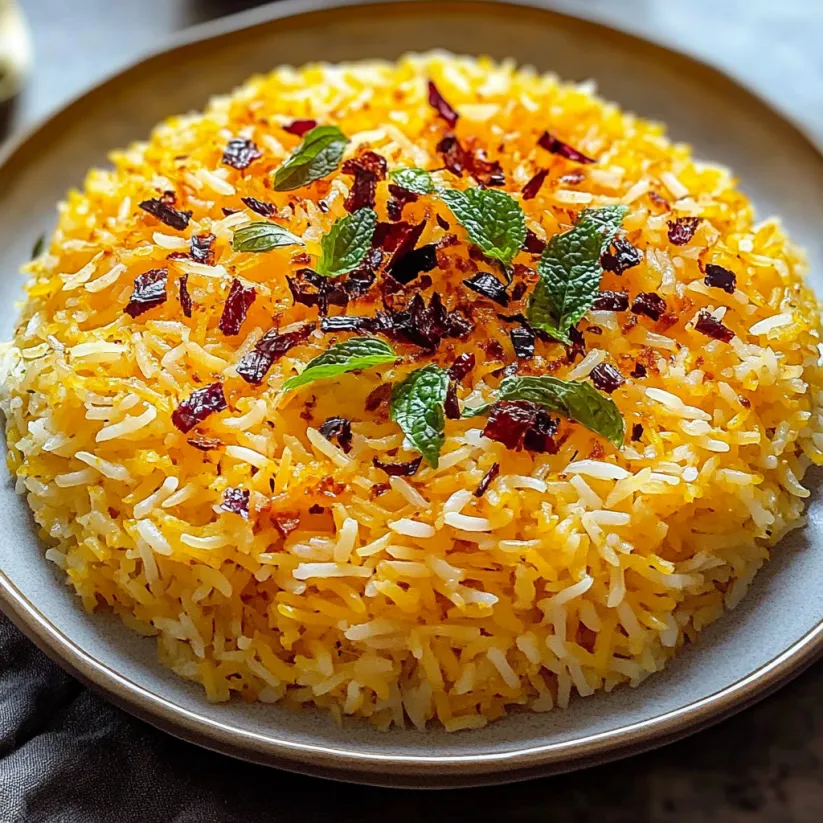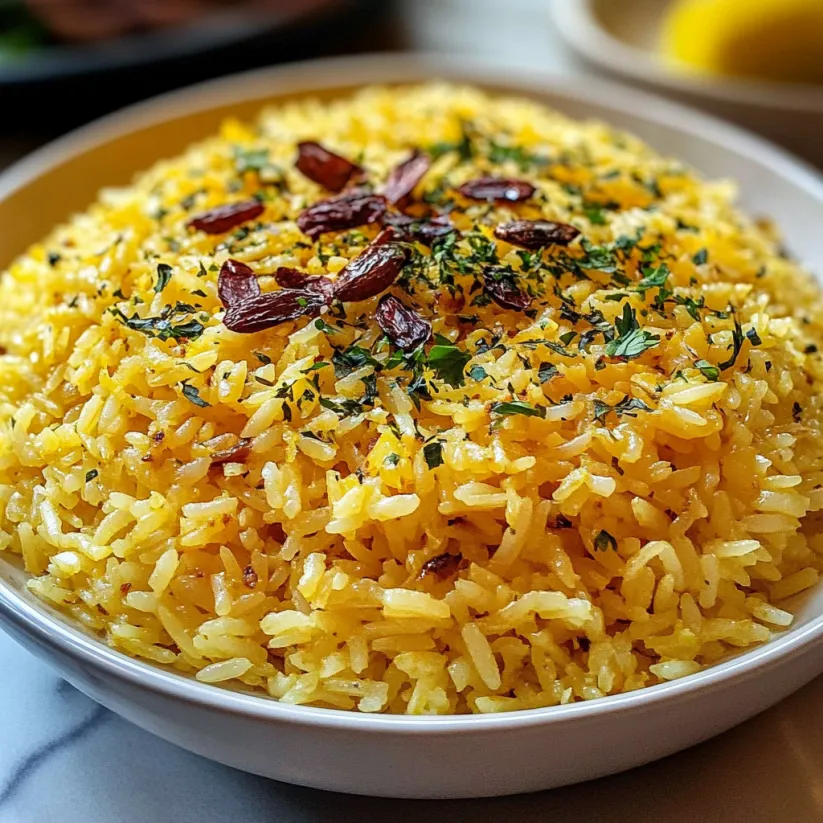 Bookmark
Bookmark
There’s nothing like lifting the lid off a steaming pot of Persian rice. The warmth, the aroma, the anticipation…
Persian rice is where golden, crispy tahdig meets fluffy, fragrant grains. It’s a culinary tradition perfected over centuries. It’s the crown jewel of Iranian cuisine.
It took me a few tries before I mastered this delicate art.
But once you get it right, you’ll never look at rice the same again. Trust me, it’s beyond delicious!
What Is Tahdig?
Before we dive into the recipe, let’s talk about that word: tahdig. Unless you speak Persian/Farsi, you may not be familiar with it.
Tahdig literally means “the bottom of the pot.” Specifically for this recipe, it means the beautiful, pan-fried, crispy, golden crust beneath the steamed rice.
Once you finish the recipe, this layer will go on top for a gorgeous presentation.
Ingredients
- Basmati Rice: The perfect long-grain rice for producing fluffy, separate grains. Don’t substitute another type unless absolutely necessary.
- Salt: It’s more than just an essential seasoning in this recipe. It also flavors the cooking water and helps the rice maintain its structure.
- Vegetable Oil (or Butter): For the crucial golden crust at the bottom of the pot. I prefer butter for its richer taste.
- Ground Saffron: This precious spice provides the rice with its signature golden hue and floral aroma. Bloom it in hot water first to release its color and flavor.
- Plain Yogurt: Though optional, it makes the tahdig layer creamier and more complex.
- Garnishes: Pistachios, almonds, and barberries are most common. They decorate the rice and provide a bit of crunch or tartness, depending on which you use.
How to Make Persian Rice
- 1. Prepare the rice.
- Rinse the rice under cool water to remove excess starch. Then, place the rinsed rice in a large bowl. Cover completely with water and add 2 tablespoons of salt. Soak for 1 to 2 hours.
- 2. Prepare the saffron water.
- Use a mortar and pestle to grind the saffron threads into a fine powder. Pour 2 to 3 tablespoons of boiling water over the powder and set aside.
- 3. Parboil.
- Bring 4 to 6 cups of water and 2 tablespoons of salt to a boil in a large pot. Drain the soaked rice, then add it to the water. Cook for 5 to 7 minutes until al dente. Then, drain in a colander and rinse briefly with cool water.
- 4. Coat the pot.
- Thoroughly dry the pot. Then, add 2 to 3 tablespoons of oil or butter to coat it. Pour in and swirl the saffron water to evenly distribute it.
- 5. Prepare the tahdig layer.
- If using the optional yogurt, mix 2 to 3 tablespoons with 1/2 cup of parboiled rice and 1 tablespoon of saffron water. Spread the mixture evenly over the bottom of the pan. If not using yogurt, add 1/4 cup of parboiled rice to the saffron and oil.
- 6. Steam.
- Spoon the rest of the rice gently into the pot. Mound it in the center and poke holes through it with the handle of a wooden spoon. Wrap the pot’s lid with a clean towel and cover the pot tightly.
- 7. Cook
- Cook the pot of rice for 5 to 7 minutes over medium-high heat. Once you hear a sizzling sound, reduce the heat to low. Steam for another 30 to 45 minutes.
- 8. Serve.
- Once the rice is ready, turn off the heat and let the pot rest. Then, gently scoop portions onto plates or bowls. Use a spatula to loosen the tahdig layer and place it on top or beside the rice. Garnish as desired, and enjoy!
 Bookmark
Bookmark
Tips for the Best Persian Rice
Through numerous trial and error attempts, I’ve come up with some helpful tips for this recipe.
Prepare the rice properly. First and foremost, be sure to get basmati rice. It makes a difference. Then, rinse it thoroughly until the water runs clear. This removes excess starch and ensures fluffy, non-sticky grains. Finally, soak it for at least 1 hour, up to two.
Don’t overboil! When parboiling the rice, you want it soft on the outside but still firm at the center. If you overcook it when parboiling, it will become mushy after steaming.
Splurge on high-quality saffron. I know saffron is expensive. Luckily, you can typically buy small containers for $10-$15. Buy smaller, if necessary, to get a high-quality product. I like the Zaran brand best.
Be generous! Add two heaping tablespoons of salt to a large pot when parboiling the rice. Most of it will be rinsed away. Also, add plenty of oil for the tahdig layer. A little saffron goes a long way, though.
Why wrap the lid? Wrapping the lid in a clean kitchen towel helps absorb moisture. As the rice steams, condensation will form. The towel will absorb and prevent it from dripping back into the rice.
Don’t rush the steaming. I’m fond of the phrase “low and slow” when cooking rice, especially Persian rice. The low-heat, slow steaming process is key to achieving the rice’s fluffy texture. It takes a bit of time, so be patient.
Listen carefully. Really listen for the sizzling sound of the tahdig forming. As soon as you hear it, reduce the heat to low to avoid burning the crisp bottom layer.
 Bookmark
Bookmark
How to Serve Persian Rice
For the most impressive presentation, flip the entire pot onto a serving platter in one smooth motion. This will invert the dish and reveal the golden tahdig on top.
As for what to serve with the dish, you have lots of options. Here are some of my favorites:
- Persian stew or other thick, hearty stews
- Kebabs or other grilled meats
- Salads or vegan recipes
- Roasted chicken
- Plenty of garnishes
How to Store
I don’t recommend freezing Persian rice, as it will negatively impact the texture. However, you can keep leftovers for a few days.
To Store: Let the rice cool, then transfer it gently to an air-tight container. (Don’t pack it in or push it down. Both will make the rice clumpy.) Refrigerate for up to 5 days.
To Reheat: For best results, steam the rice in a covered pot over low heat. Add a splash of water and heat for 5 to 7 minutes until warm. Or, transfer the rice to a microwave-safe bowl. Sprinkle a tablespoon or two of water on top and microwave in 30-second intervals.
Frequently Asked Questions
- → What type of rice is best for Persian rice?
Basmati rice is ideal due to its long grains and ability to stay fluffy and separate after cooking. Avoid substitutions for best results.
- → How do I get the tahdig perfectly golden and crisp?
Use enough butter or oil, let the rice steam on low heat, and listen for a gentle sizzle before reducing heat. Patience is key.
- → Can I make Persian rice without yogurt?
Yes, yogurt is optional. It adds creaminess to the tahdig but can be replaced with saffron water and rice for a simpler version.
- → What does saffron do in this dish?
Saffron gives the rice its golden color and floral aroma. Blooming it in hot water enhances its full flavor and visual appeal.
- → What should I serve with Persian rice?
Pair it with Persian stews, kebabs, grilled meats, or hearty vegetables. Garnishes like pistachios and barberries also elevate the dish.
- → How do I store and reheat leftovers?
Refrigerate in an airtight container without compressing the rice. Reheat gently with added moisture, either on the stove or in the microwave.
